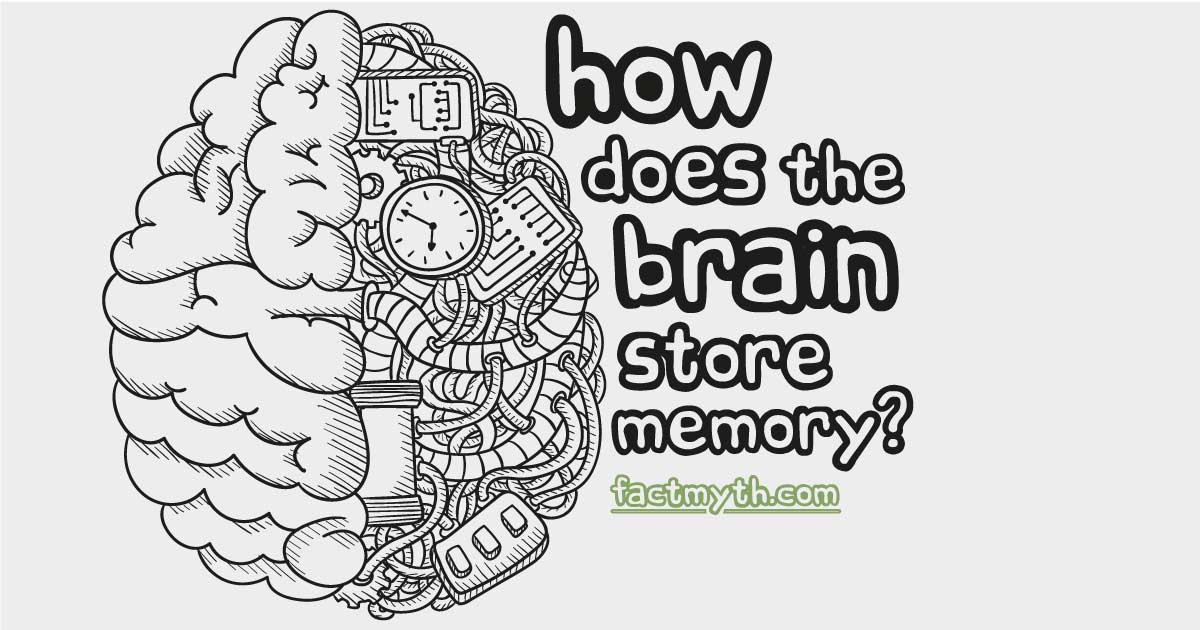Neuroscience still hasn’t proved the specific workings of the brain in every respect, instead we rely on a mix of brain scans, studies, and models. We know that memory isn’t limited to just one part of the brain, but figuring out the exact mecahnics is still a work in progress.
Memories are Stored in a Single Part of the Brain myth

Where Does the Human Brain Store Memories?
Memories aren’t stored in a single part of the brain. Memories are stored in neurons located in different parts of the brain, recalled using other parts, and connected to even more parts via synaptic pathways. Memory, learning, and cognition, in general, are complex processes that use nearly every part of the brain between sensing, encoding, storing, and recalling memories. This helps explain why the idea that we only use 10% of our brain is a myth.[1][2]
TIP: Memory isn’t just one thing, it’s a broad term that means “information of any type stored in our brain” via our sensory memory, short-term memory, long-term memory, or even our own thought process. It is a complex system that can’t be properly summarized in only few words. See a breakdown form human-memory.net.
In What Parts of the Brain are Engrams Encoded?
Memories (or “engrams”) are mostly stored in the frontal cortex and hippocampus, but not exclusively (the frontal lobe, motor cortex, cerebellum, amygdala, temporal lobe, prefrontal cortex are all involved as well). Beyond this, every single memory is attached to pretty much every other area of the brain via synaptic networks. So when we recall a memory we are using most of our brain to bring up many interacting blips of sensory information, and then, even more areas are working to turn that into a useful composite image. Yet, studies show, that each part of a sensory memory is actually stored in specific neurons, related to the information type in their respective area of the brain and that memory can potentially be effected with light, by employing modern neurological technology.[3][4]
How does your memory work? | Head Squeeze – Brit Lab. Not only do memories get stored in different parts of the brain, they network with just about every other part of the brain in the storage and recall process. Our brain naturally employs teamwork, helping to explain why humans are social creatures. #Cooperation. See the brain map in action here.TIP: The human brain is an electro-chemical computer. It is very different from a binary computer in terms of encoding, storage, and recall.

Source: Pixabay.com
The Semantic Map of the Brain – Synaptic Connections
A Recent study, Natural speech reveals the semantic maps that tile human cerebral cortex, paints a clearer picture of the brain by showing that those specific areas of the brain are mapped to specific semantic meanings of words. For example, meanings related to people in one area, meanings related to numbers in another, etc.[5][6]
The brain dictionary. Not only do memories get stored all over, but just semantic meaning alone paint a map of that spans the entire brain. Our brain naturally employs teamwork. #Cooperation. See the brain map in action here.This means there isn’t one single part of the brain devoted to memory and learning. There are specific neurons devoted to storing sensory information in different areas of the brain. Many parts of the brain work together to create the process we call learning and memory. The memory process becomes especially complex when we consider memory recall.
The sensory information we store is connected via synapses when neurons are stimulated, and that allows us relate one data blip to another, to form our understanding of the world.
Interestingly, it has been shown, that in a damaged brain, other areas of the brain will pick up the slack and start encoding and processing an other area’s information This hints that the brain is flexible when it comes to storing information.[7]
When we remember something or store a memory we are utilizing many different parts of the brain, and those neurons are firing and wiring themselves together with the rest of our brain.
- Learn more about how memory works.
- Learn more about how synaptic connections are made (neuroplasticity).
TIP: This means that the plots to Total Recall or Eternal Sunshine of the Spotless Mind aren’t necessarily beyond the realms of science, although they are not out of the realm of science fiction yet either. Memories may be able to be implanted and erased; we don’t know yet. The following video explains how memories can be activated by light.
Controlling the brain with light to reactivate lost memories | Susumu Tonegawa.TIP: If we think about the social sciences, the new findings become more interesting. The implication is that influence could shape a person’s viewpoints in really bizarre ways. If we store semantic meanings in such a structured way, one might be able to manipulating others with scientific, laser-focused precision. This isn’t exactly a cheery thought, but certainly it is an interesting one. Learn more about the neuroscience of bias, or change, resistance, and adaptation.
The Neuroscience of Memory – Eleanor Maguire – The Royal Institution.- “Where Are Old Memories Stored in the Brain?” Scientificamerican.com
- “MEMORY STORAGE” Human-memory.net
- “Optogenetic stimulation of a hippocampal engram activates fear memory recall” Nature.com
- MIT discovers the location of memories: Individual neurons” Extremetech.com
- “Natural speech reveals the semantic maps that tile human cerebral cortex” Nature.com
- “Scans Show ‘Brain Dictionary’ Groups Words By Meaning” Breakthroughs.kera.org
- “Damage to prefrontal cortex compensated by intact areas; ‘Phantom’ images stored in flexible network throughout brain” Sciencedaily.com
